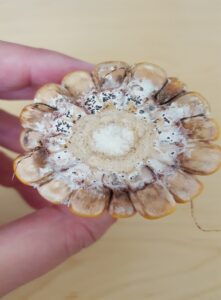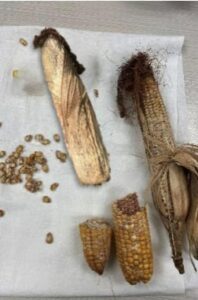Diplodia Ear Rot

Diplodia ear rot (DER) is caused by the fungal pathogens Stenocarpella maydis, which is also the causal agent for Diplodia Stalk Rot, and S. macrospora, which is also associated with the foliar disease – Diplodia leaf streak. The occurrence of Diplodia ear rot has increased since the adoption of no-till systems.
Symptoms: DER can be observed in plants as early as R3 (Milk) stage. Infected husks are often bleached while the rest of the plant remains green. The identifying characteristic of the fungi are white mold starting at the base of the ear and as the rot progresses the whole ear becomes grayish-brown. The presence of raised black bumps (pycnidia) that develop on the moldy husk or kernels late in the season is also a distinguishing feature.
Favorable conditions: Dry weather followed by wet conditions during R1 (silking) favor the pathogens that can cause infection of the ear, and delayed harvest can make disease more severe, further reducing grain quality and yield. Birds and insect damage to the ears also predispose plants to infection.
Yield penalty: Infected kernels are lightweight and have reduced nutritional value. The friable nature of the infected ears can also result in more cobs and kernels being ground up during the combine shelling operation, resulting in higher levels of broken and foreign material. It was estimated that 167 million bushels were lost between 2012 and 2015, across USA and Canada due to DER (Mueller et al 2016).
Management: The most important source of inoculum of DER is the debris of diseased corn stalks from the previous crop, therefore reducing surface residue through tillage is an effective practice to control disease. However, where tillage is not suitable, growers should look for hybrids that are less susceptible and rotate to non-host crops.


